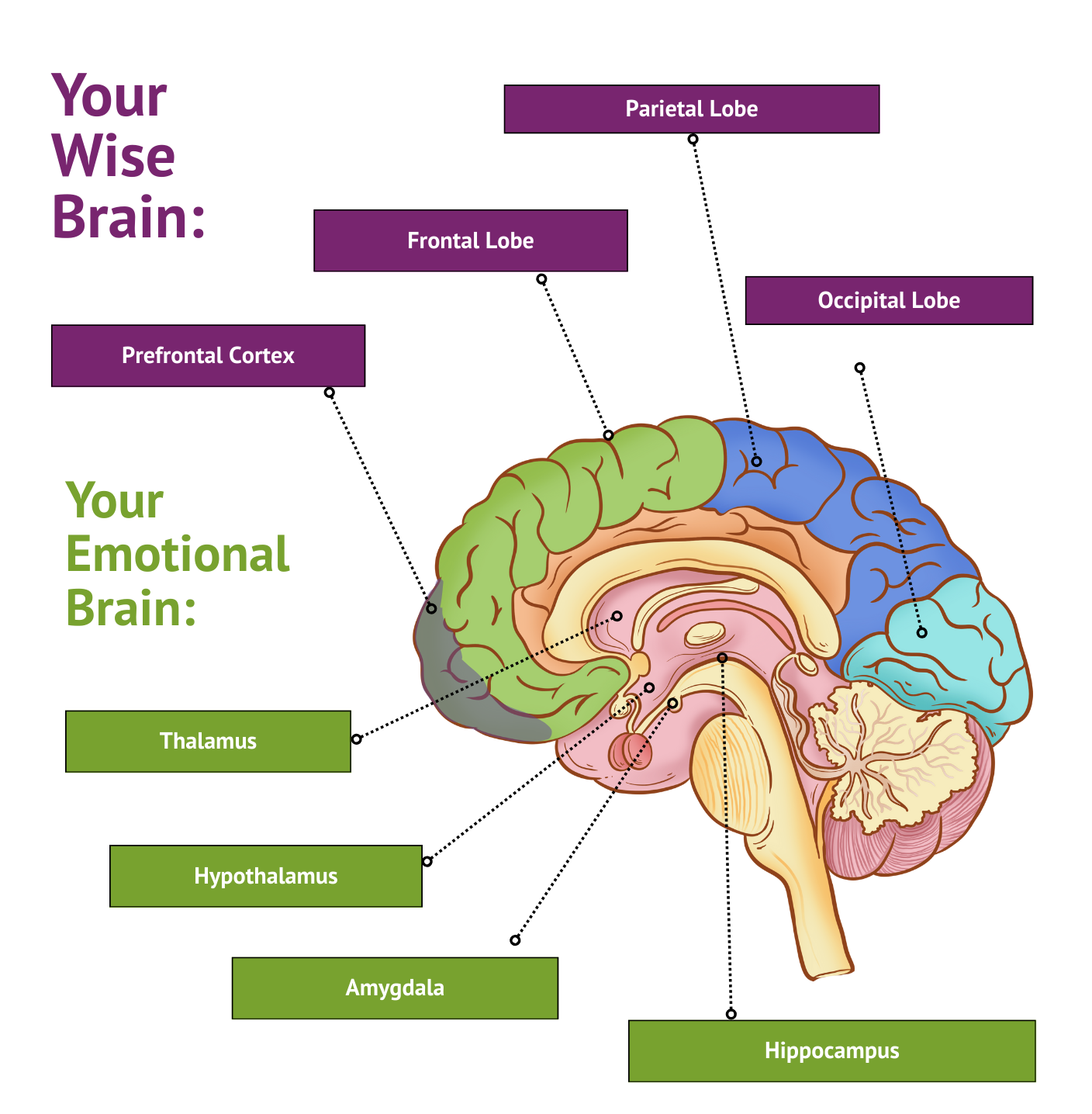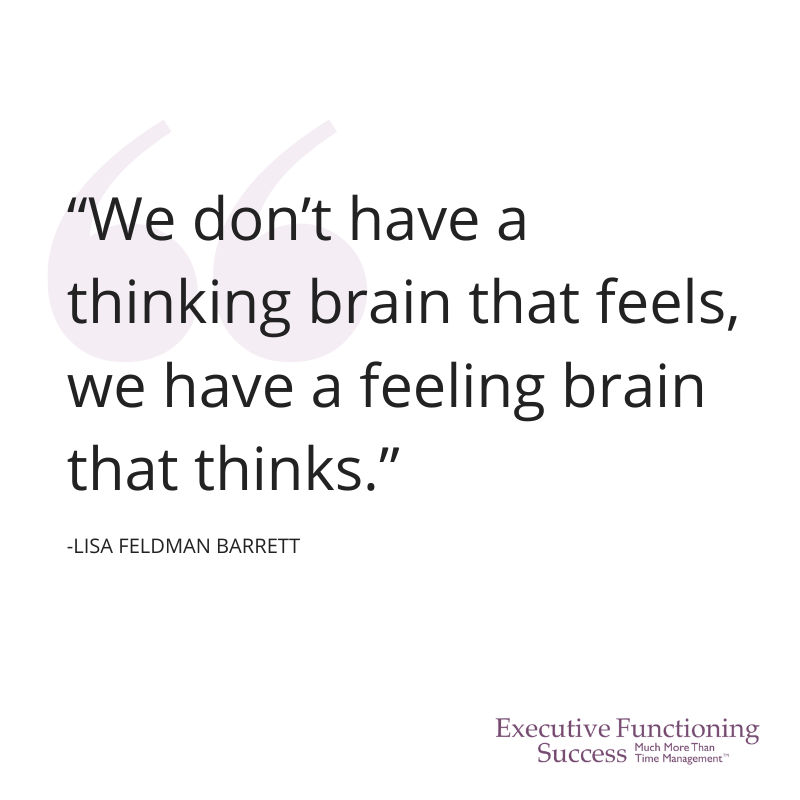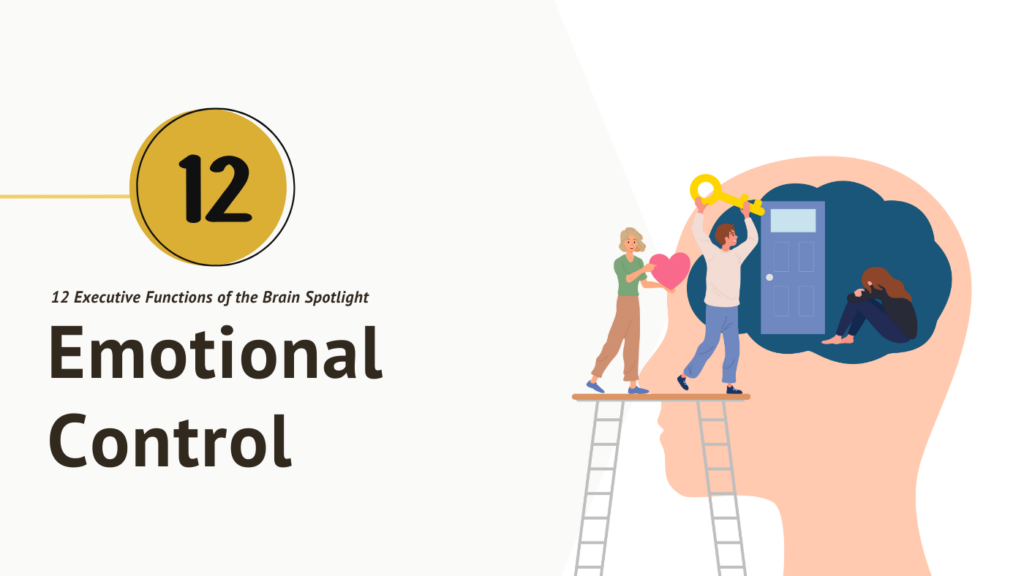Over my decades of work with executive functions, I’ve found that two executive function skills are absolutely essential. The first is metacognition, which we talked about in the very first post of our 12 Executive Functions of the Brain Series.
In this final installment of the series, it is time to address the second executive function skill that is the linchpin for successful executive functioning: Emotional Control.
Understanding how your brain works is essential for using and strengthening the executive function skill of emotional control.
To get a simple picture of how emotional control works, I like to divide the brain into two areas: your “wise” prefrontal cortex, home to most of your executive functions, and your “emotional brain” located within the limbic system. This division is important to wrap your mind around.
How the Limbic System (Emotional Brain) Takes Over
One of my favorite quotes about the brain comes from neuroscientist Lisa Feldman Barrett: “We don’t have a thinking brain that feels, we have a feeling brain that thinks.”
This means that we humans do not walk around responding to the world around us while being directly connected to our higher-order thinking brain. No, we walk around responding to the environment with the emotional brain FIRST.
Why does this progression of emotion before thinking exist? It has to do with survival and how information enters your brain. All sensory information – what you see, hear, touch, smell, taste and “feel” – first has to go through the limbic system. This is deep within the interior of the brain, around the top of the brain stem.
The key player in the limbic system is the amygdala, which I like to describe as the “security guard” in the brain. The amygdala is constantly screening your surroundings to determine whether or not you are safe in the moment.

Because the bottom line is that your brain wants you to survive to live another day. That’s it! (Well, technically we are supposed to live another day so that we can procreate for species survival, but I’m not going to go there…)
If the amygdala determines that you are safe, that all is well in the space/world around you, then, and only then, will it let you use your wise prefrontal cortex to think, learn and problem-solve rationally.
However, if the amygdala senses any kind of threat to your survival, it activates your sympathetic nervous system. It will set off a chemical reaction that shoots cortisol, a powerful stress hormone, into the fluid of your brain.
This cortisol interrupts communication between the neurons, shutting down access to your prefrontal cortex, your wise brain. At this point, you cannot think. You can only react to your sympathetic nervous system. It is a flashing warning message shouting “DANGER! DANGER!” You are stuck in fight, flight or freeze.
This is a very practical function of the brain left over from the days when humans were stalked by things like sabertooth tigers. It helps you to REACT quickly (not think) in order to survive a REAL danger. But in this stressful modern world, with information overload, the fight/flight response can get tripped easily leaving you in perpetual fight or flight, despite the absence of an immediate true danger.
How the Limbic System Sabotages Your Executive Functions
So what does the limbic system, or emotional brain, have to do with your executive functioning?
EVERYTHING.
With an activated amygdala, your capacity to use strong executive functioning skills shuts down. You start forgetting things, miss appointments and lose track of time. You also lose motivation to do the things you don’t want to do, but need to do. Your connection to future thinking is gone, stuck in the emotion of the moment.
This means all those goals, projects and deadlines that require you to take action are ignored. As a result, your stress levels rise. You become overwhelmed and anxious when you start dropping the balls you have been trying to keep in the air.
Inevitably, trouble mounts at home, school or work as you spin in your emotions. Relationships suffer. Your health suffers. Life feels awful. You are STUCK in dysfunction. Fear, anxiety or anger dominate. Your self-esteem disappears. Your emotional brain controls your behavior and, in essence, your life.
It is PAINFUL.
Why do I know this is true? For starters, I lived with it before I fully understood what was going on in my brain.

My personal experience is not unique, however. Through my long career in this field, I have worked with hundreds and hundreds of people who arrive to participate in the Seeing My Time® program, woefully stuck in their emotional brains.
They are desperate to make changes but don’t know how. They’ve tried medications, counseling, coaching, journaling, psychological testing, diets, etc. Those methods may have helped, but not enough to truly gain control over their emotional brain’s dominance.
How Do You Escape From the Clutches of Your Emotional Brain?
Proper knowledge and self-awareness will set you on the path to freedom. That’s why The Seeing My Time® Program is a carefully designed sequential curriculum that sets the stage for behavior change.
That’s also why it starts with developing an awareness of your current behavior patterns and then the strengths and weaknesses of your brain’s executive functioning. You are armed with knowledge as to why you have these challenges.
Then you can begin to use tools to support your brain’s weaknesses. It’s a process. And it is a process that begins with learning to exert control over your amygdala so that you keep it from blocking access to your wise brain.
Top-Down Control is the Key
What is Top-Down Control? This phrase means that with age and awareness, the prefrontal cortex can override the amygdala.
The space of time to override it is very short, so you need to develop a key awareness: Where in your body do you get a physical sensation that warns you that you are about to “lose it?” Pause here and identify that location for yourself. It shows up in different places for different people.
Once you’ve found your warning signal, here’s what to do when you feel it:
- Take a deep breath. Closing your eyes will help.
- Focus on the sensation of the soles of your feet being grounded on the floor.
- Roll your shoulders back so that you get a slight arch in your lower back. The arch activates your parasympathetic nervous system by setting off a chemical reaction that lowers your heart rate.
- Take a few more deep breaths, focusing on inhaling and exhaling.
- If a particular trigger thought keeps popping back into your mind, visualize a big red “STOP” sign. Focus on the sign, feeling your feet.
- After a couple of minutes, you can open your eyes. Wiggle a bit.
- Now move on to something that you can do or accomplish in this moment. Do it. Taking action puts you back in control with access to your wise brain!
We are living in an extraordinary time of uncertainty. Many of us have significant concerns over the future, both near and far. Our amygdalas are working overtime, monitoring threats, real or imagined. We are anxious for personal survival/safety and the safety of others.
All of this means that we are extremely vulnerable to the dominance of the amygdala and people who understand this. It means that it is very easy to be manipulated by others who don’t want us to think or act rationally.
So, dear friends, take care, pause, and use top-down control to keep in charge of your life and your executive functioning. Keep yourself and those around you centered. Be a positive beacon of hope for the world by using your wise brain to make good choices. Doing so helps us all.
Stay grounded…Little by little…change happens.


